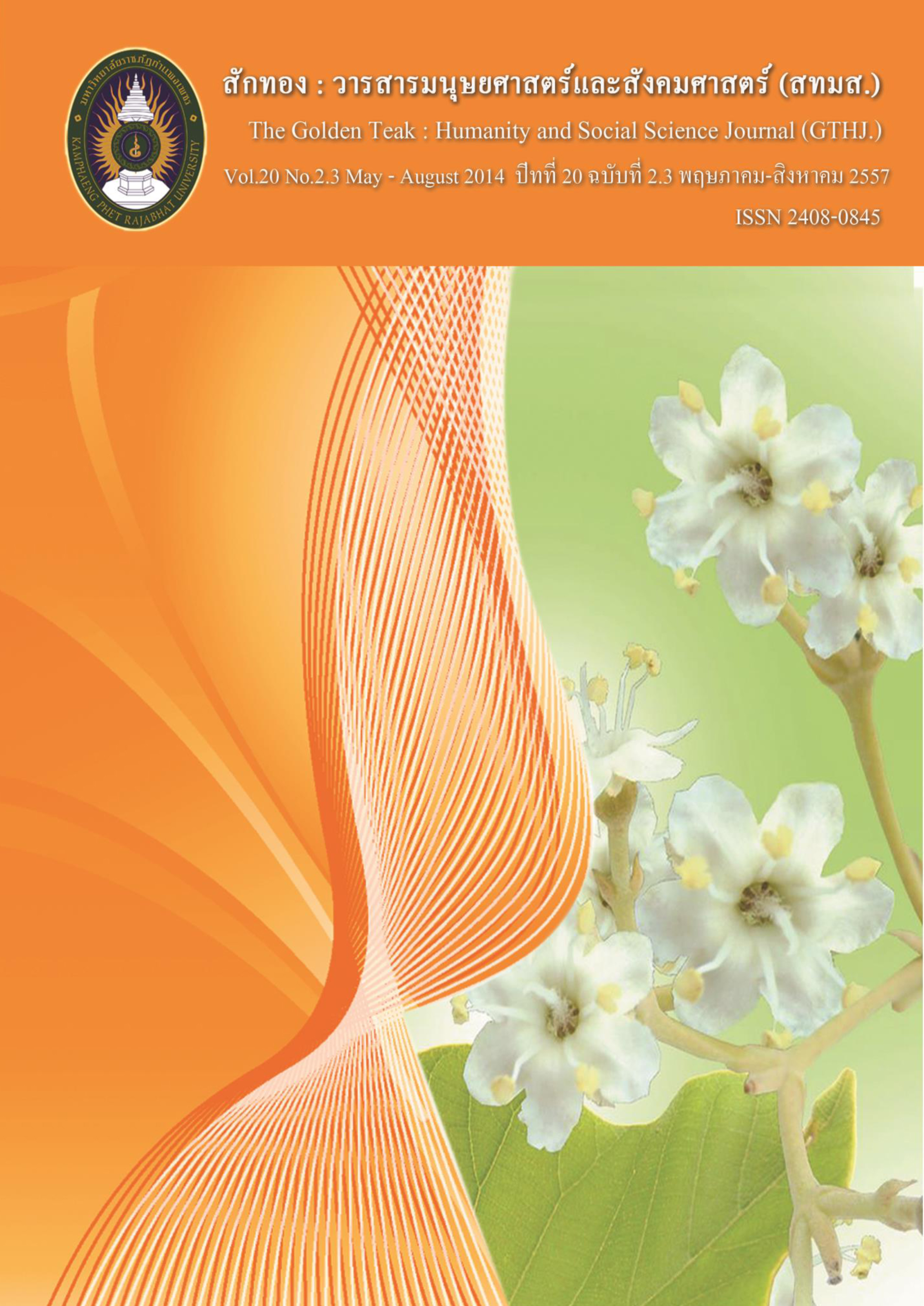การพัฒนาแนวคิดเรื่อง ปฏิกิริยานิวเคลียร์ ของนักเรียนชั้นมัธยมศึกษาปีที่ 6โดยการจัดการเรียนรู้ตามทฤษฎีแห่งการสร้างสรรค์ด้วยปัญญา
Main Article Content
Abstract
ABSTRACT
The objective of the research was to develop 12th grade students’ understandingof the scientific conceptions of Nuclear Reaction through Constructionist learning approach. The participants of this study were 15 volunteers of 12th grade students in the largest school in Saraburi province in the second semester of academic year 2013. The research instruments were lesson plans, a scientific concept test of Nuclear Reaction, students’ journals, and informal interview logs. The researcher analyzed quantitative data with calculation of the frequencies and percentages, and analyzed qualitative data with content analysis. The findings indicated that teaching with Constructionist learning approach could enhance the students’ understanding of scientific concepts on the Nuclear Reaction. The findings also showed that most students understood the conception of the composition of the nucleus increased from 26.57% to 93.33%, the conceptions of binding energy increase from 6.67% to 100.00%, the conceptions of nuclear reaction increased from 0.00% to 93.33%, the conceptions of nuclear fission reaction increased from 0.00% to 66.67% the conceptions of chain reaction increased from 0.00% to 66.67% and the conceptions of nuclear fusion increased from 13.33% to 80.00%. Moreover, most students had no conception of nuclear reactions and misconception in the concept of binding energy before teaching with this approach. However, students increasingly understood the concept of nuclear fission, and chain reactions after teaching. Moreover, some of them had a partial conception. However, no one had complete misconception and no conception after teaching with this approach.
Article Details
บทความที่ได้รับการตีพิมพ์เป็นลิขสิทธิ์ของวารสาร สักทอง : วารสารมนุษยศาสตร์และสังคมศาสตร์ สถาบันวิจัยและพัฒนา มหาวิทยาลับราชภัฏกำแพงเพชร
ข้อคิดเห็นใดๆ ที่ปรากฎในวารสารเป็นวรรณกรรมของผู้เขียนโดยเฉพาะ ซึ่งมหาวิทยาลัยราชภัฏกำแพงเพชรและบรรณาธิการไม่จำเป็นต้องเห็นด้วย
References
ด้วยปัญญา เรื่อง การสร้างหนังสืออิเล็กทรอนิกส์ สำหรับนักเรียนชั้นมัธยมศึกษาปีที่ 1.
วิทยานิพนธ์ศึกษาศาสตรมหาบัณฑิต (เทคโนโลยีการศึกษา) ภาควิชาเทคโนโลยีการศึกษา.
สาขาวิชาเทคโนโลยีการศึกษา มหาวิทยาลัยเกษตรศาสตร์.
เฉลิม รอดหลง. (2529). การศึกษาสมรรถภาพ ปัญหาและความต้องการของครูวิทยาศาสตร์ระดับ
มัธยมศึกษาตอนต้น ในโรงเรียนมัธยมศึกษาระดับตำบล เขตการศึกษา 6.
วิทยานิพนธ์ศึกษาศาสตรมหาบัณฑิต มหาวิทยาลัยเกษตรศาสตร์.
ธณัฐพร จันทร์แสง. (2551). การประเมินโครงการพัฒนากระบวนการเรียนรูเพื่อสร้างสรรค์
ดวยปญญา โรงเรียนบานสันกําแพง จังหวัดเชียงใหม่. วิทยานิพนธ์ศึกษาศาสตรมหาบัณฑิต
(การบริหารการศึกษา). สาขาวิชาการบริหารการศึกษา, มหาวิทยาลัยเชียงใหม่.
นริศ มะสกุล. (2543). ผลการใช้คอมพิวเตอร์ช่วยสอนทบทวน วิชาวิทยาศาสตร์กายภาพ
ชีวภาพเรื่องปฏิกิริยานิวเคลียร์ ระดับมัธยมศึกษาตอนปลาย.
วิทยานิพนธ์ครุศาสตร์อุตสาหกรรมมหาบัณฑิต (การศึกษาวิทยาศาสตร์) คณะครุศาสตร์
อุตสาหกรรม. สถาบันเทคโนโลยีพระจอมเกล้าเจ้าคุณทหารลาดกระบัง.
บุปผชาติ ทัฬหิกรณ์. (2546). เทคโนโลยีสารสนเทศทางวิทยาศาสตร์ศึกษา. กรุงเทพฯ :
มหาวิทยาลัยเกษตรศาสตร์.
. (2552). การประยุกต์ใช้เทคโนโลยีสารสนเทศในการเรียนการสอน.พิมพ์ครั้งที่ 2.
กรุงเทพฯ : สำนักเทคโนโลยีเพื่อการเรียนการสอน สำนักงานคณะกรรมการการศึกษาขั้นพื้นฐาน.
ภัทรลักษณ์ สังข์วงษ์. (2556). การพัฒนาความคิดอภิปัญญาโดยการจัดกิจกรรมการเรียนรู้ตามทฤษฎี
การเรียนรู้เพื่อสร้างสรรค์ด้วยปัญญา เรื่อง วิวัฒนาการของนักเรียนชั้นมัธยมศึกษาปีที่ 6.
วิทยานิพนธ์ศึกษาศาสตรมหาบัณฑิต (วิทยาศาสตร์ศึกษา) ภาควิชาการศึกษาศาสตร์.
สาขาวิทยาศาสตร์ศึกษา มหาวิทยาลัยเกษตรศาสตร์.
ศึกษาธิการ, กระทรวง. (2542). พระราชบัญญัติการศึกษาแห่งชาติ พ.ศ. 2542 และที่แก้ไขเพิ่มเติม
พ.ศ. 2545. กรุงเทพฯ : โรงพิมพ์คุรุสภาลาดพร้าว.
. (2551). หลักสูตรแกนกลางการศึกษาขั้นพื้นฐาน พุทธศักราช 2551.
กรุงเทพฯ : โรงพิมพ์ชุมนุมสหกรณ์การเกษตรแห่งประเทศไทย.
อุทิศ บำรุงชีพ. (2551). รูปแบบการเรียนการสอนผ่านเว็บตามแนวคอนสตรัคชันนิซึมเพื่อพัฒนาความคิด
สร้างสรรค์. วิทยานิพนธ์ศึกษาศาสตรดุษฎีบัณฑิต (เทคโนโลยีการศึกษา) ภาควิชาเทคโนโลยี
การศึกษา สาขาวิชาเทคโนโลยีการศึกษา มหาวิทยาลัยเกษตรศาสตร์.
Abraham, M.R., V.M. Williamson, and S.L. Westbrook. (1994). “A Cross-Age Study of the
Understanding of Five Chemistry Concepts.” Journal of Research in
Science Teaching, 31(2), 147-165.
Haidar, A.H. (1991). “A comparison of applied and theoretical knowledge of concepts
Based on the particulate nature of matter.” Journal of Research in Science
Teaching, 28(10), 919-938.


